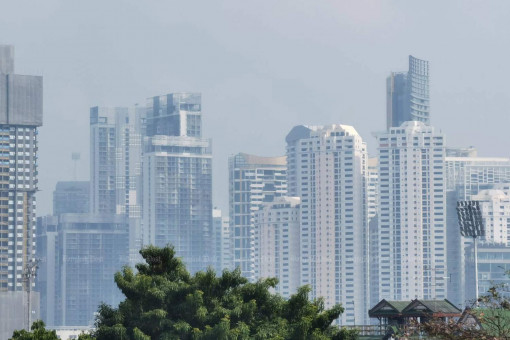PUBLISHED : 13 Dec 2023 at 10:51

Dangerous levels of ultrafine dust covered 33 of the 77 provinces on Wednesday morning, an improvement on 47 provinces on Tuesday morning, and the peak pollution level was also down.
The Geo-Informatics and Space Technology Development Agency (Gistda) reported at 9am on Wednesday that red levels of particulate matter 2.5 micrometres and less in diameter (PM2.5) covered five provinces in the Central Plain, compared with 15 provinces on Tuesday morning.
The seriously harmful (red-code) levels ranged from 75.7 to 95.2 microgrammes per cubic metre of air over the past 24 hours, down from 78.6-134.8µg/m³ on Tuesday. The government’s safe threshold is 37.5µg/m³.
On Wednesday morning the highest PM2.5 level, 95.2µg/m³, was recorded in Samut Sakhon province, followed by 86.3µg/m³ in Nakhon Pathom, 83.1µg/m³ in Rayong, 75.8µg/m³ in Bangkok and 75.7µg/m³ in Samut Prakan.
Twenty-eight other provinces in the Central Plain were blanketed with orange levels of PM2.5 ranging from 37.7 to 71.9µg/m³, meaning the levels of PM2.5 had started to affect health.
They were, in ascending order of PM2.5 levels, Nakhon Ratchasima, Phichit, Sa Kaeo, Nan, Kamphaeng Phet, Lop Buri, Lamphun, Uttaradit, Uthai Thani, Phetchabun, Ayutthaya, Phitsanulok, Nakhon Nayok, Saraburi, Tak, Prachin Buri, Chanthaburi, Sukhothai, Prachuap Khiri Khan, Samut Songkhram, Suphan Buri, Kanchanaburi, Chachoengsao, Phetchaburi, Pathum Thani, Ratchaburi, Chon Buri and Nonthaburi.
Forty-four provinces were within safe levels, most in the North, South and Northeast.
The lowest level of PM2.5, at 9.0µg/m³, was reported in the northeastern province of Yasothon, followed by 9.7µg/m³ in Amnat Charoen, 12.3µg/m³ in Si Sa Ket and 13.2µg/m³ in Surin which are also in the Northeast.
Pansak Thiramongkol, director for air and noise quality management at the Pollution Control Department, told the Thai PBS TV channel on Wednesday morning that the high levels of PM2.5 in the Central Plain resulted mainly from burning of harvest waste in paddy fields, to prepare for the next crop.

